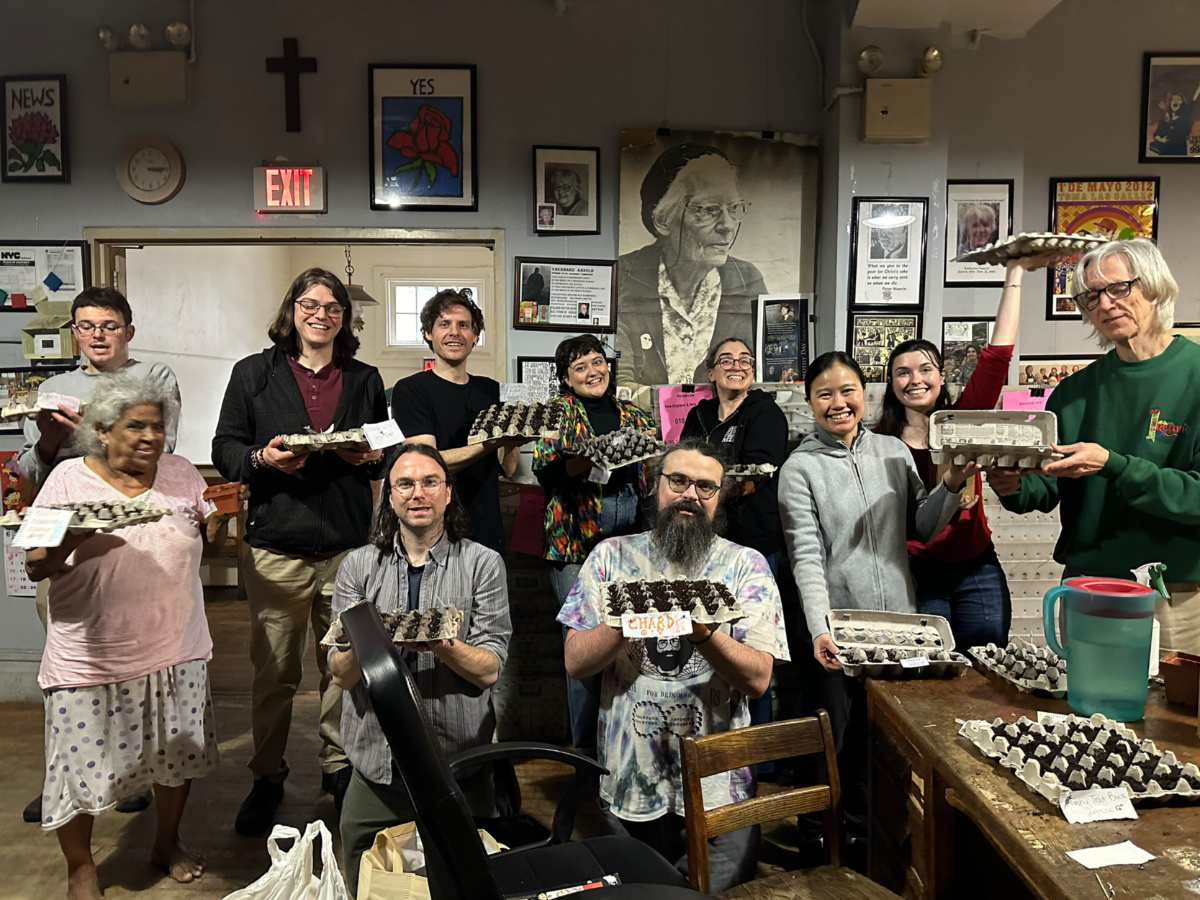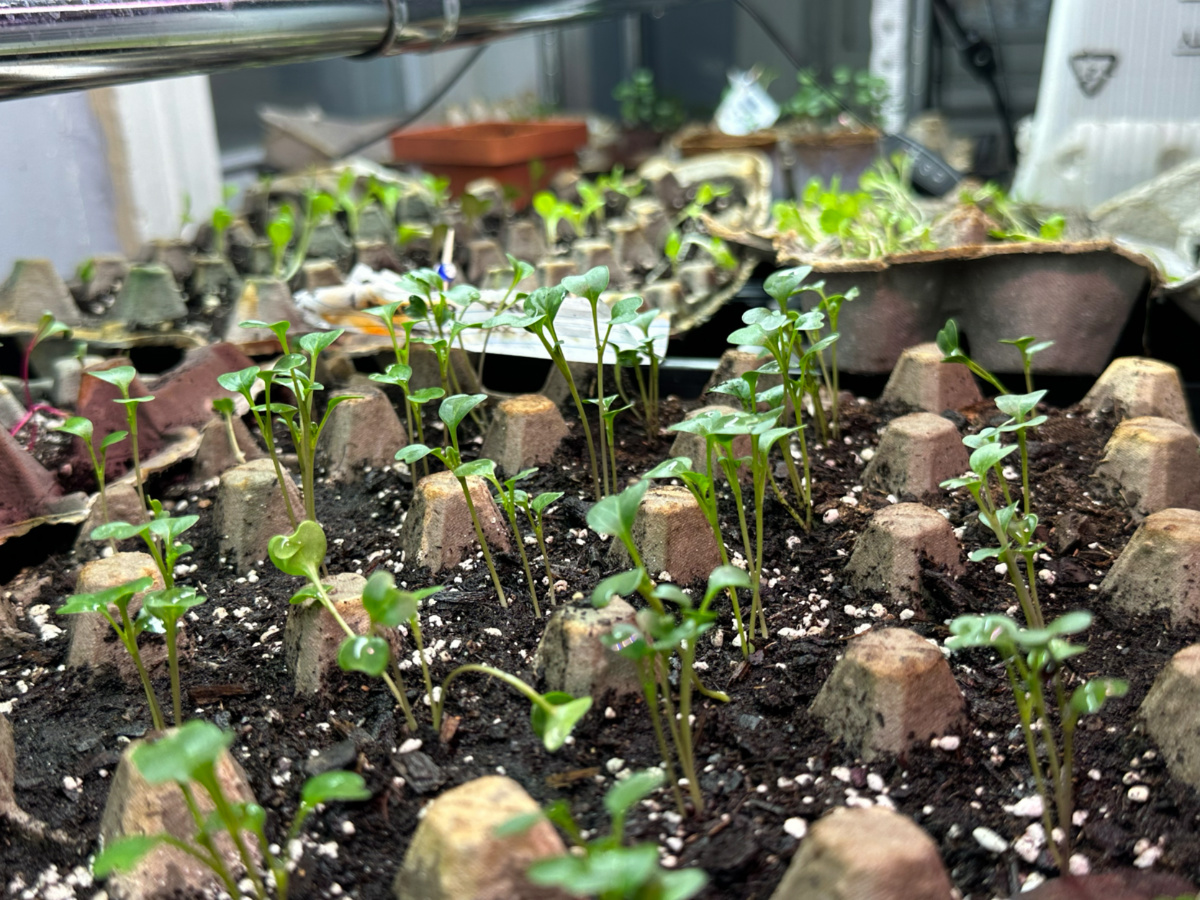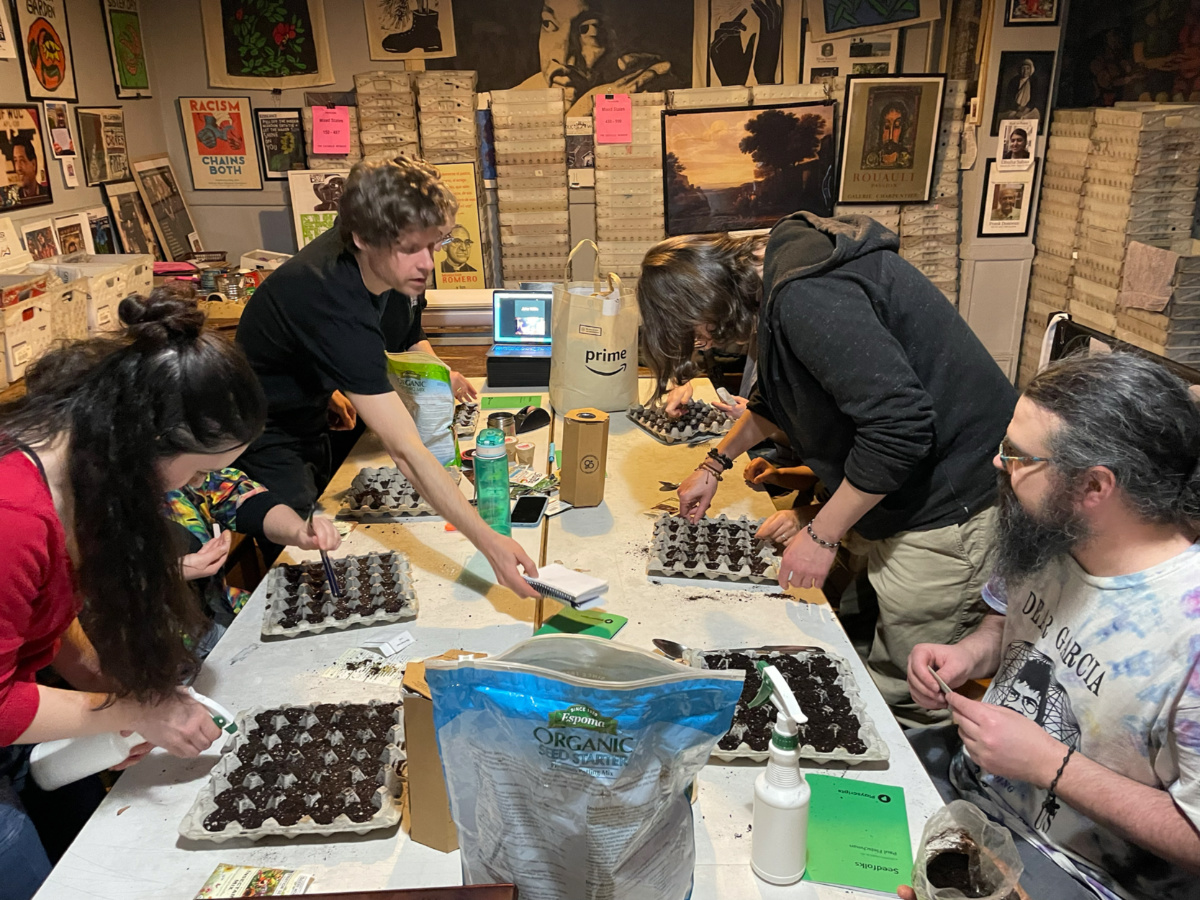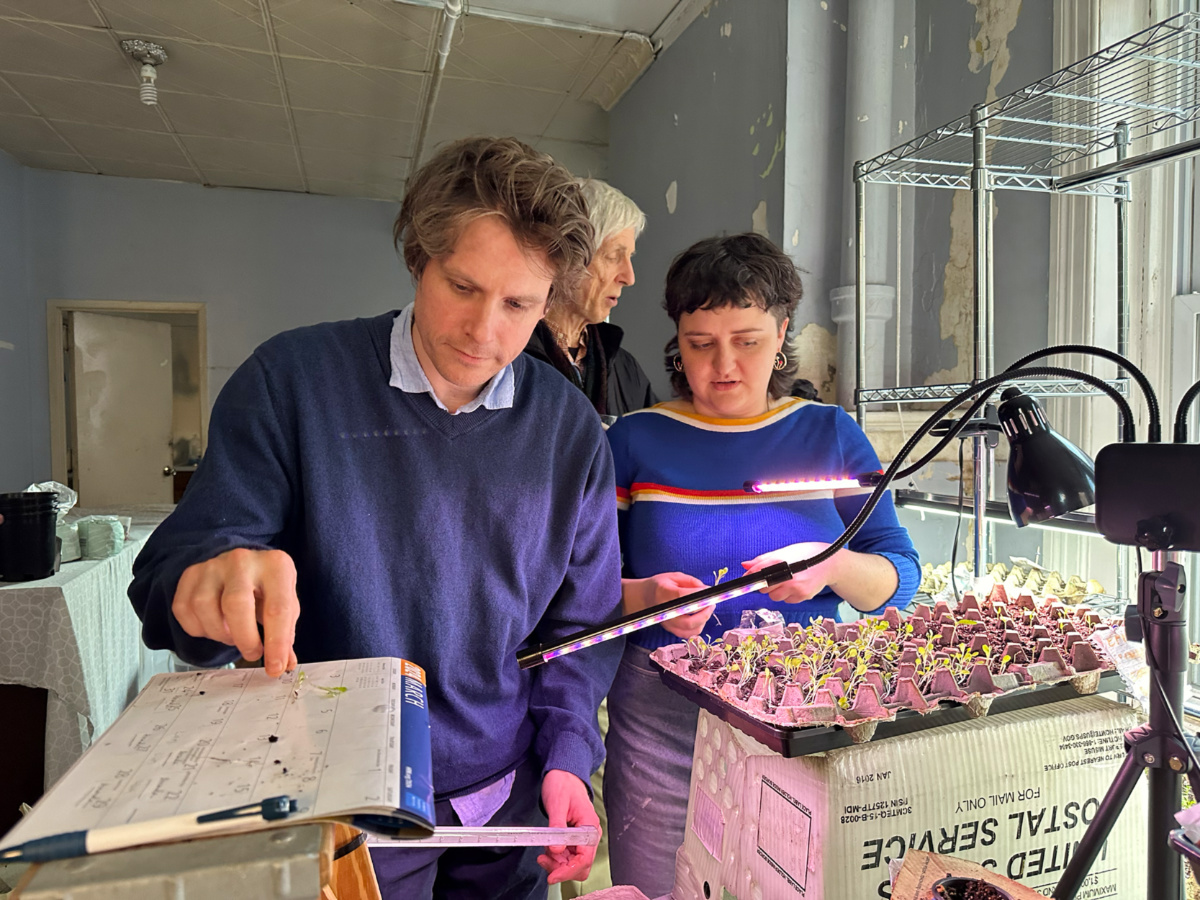
Inspired by Pope Francis’ apostolic letter on ecology, a garden planned for the roof of the movement’s historic Maryhouse has attracted new attention to Dorothy Day’s Catholic service organisation. FIONA MURPHY, of Religion News Service, reports…
New York City, US
RNS
For decades the Catholic Worker movement has served meals at its two soup kitchens at Maryhouse and St Joseph House in Manhattan’s East Village, feeding hungry New Yorkers from the thousands of pounds of fresh produce the workers grew at a farm in upstate New York named for the movement’s co-founder, Peter Maurin.
Every fall, workers at the 49-acre farm in Marlboro, New York, transported kale, onions, potatoes and other fresh produce to the houses.
“Back in the 1980s we went back and forth to the farm regularly,” said Bernie Connaughton, who has been part of the Catholic Worker movement for more than 40 years.

The New York Catholic Worker’s Integral Ecology Circle gathers for a photo holding newly planted vegetable seedlings. A cutout of Dorothy Day, the founder of the movement, hangs above the group in the chapter’s Maryhouse buildings on Third Street in Lower Manhattan on 11th March, 2024, in New York. PICTURE: Fiona Murphy.
But in 2022, the farm’s owner and Catholic Worker stalwart, Tom Cornell, died, and while his son Tommy has taken charge of operations, his health isn’t good and the farm has fallen into disrepair.
“The farm is a mess right now,” Tommy Cornell said. “There is no farming actually going on anymore. I can’t carry it.”
“We are building something new in the shell of the old.”
– Jim Robinson, professor of religious studies at Iona University and a member of the newly founded Integral Ecology Circle.
But at Maryhouse – where tattered photos of Jesus cover the walls and visiting groups sometimes ask to see the bedroom that was used by Maurin’s co-founder, Dorothy Day, who is in the process of becoming a saint – something new is growing. Inspired in part by Maurin’s dream of “agronomic universities” – communal farms where workers would learn to work the land – a group of veteran and younger Catholic workers has planted a garden on the roof of the historic Maryhouse, the 19th century building where Day lived and worked until her death in 1980.
“We are building something new in the shell of the old,” said Jim Robinson, professor of religious studies at Iona University and a member of the newly founded Integral Ecology Circle, the group behind the garden.
Dorothy Day founded the Catholic Worker in New York in 1933 with friend, social activist and French theologian Maurin. What began as an effort to publish a social justice-oriented newspaper became better known for its “houses of hospitality,” where unpaid volunteers prepare meals, give away clothes and provide shelter to people in need.
Since 1975, when Day purchased the Maryhouse on Third Street, the building has served vulnerable women in New York City and housed dozens of Catholic Worker volunteers.

Spinach sprouts in the Integral Ecology Circle’s soon-to-be rooftop garden, at Maryhouse in Lower Manhattan, on 25th March, 2024, in New York. PICTURE: Fiona Murphy.
The garden was first conceived last September, when more than 75,000 people took part in a march to end fossil fuels sponsored by a coalition of climate groups in Manhattan. Connaughton, Robinson and two other members of the New York Catholic Worker found each other in the crowd and met afterward to talk.
“We thought, how can our community respond in a more specific way to this concern?” said Liam Myers, 26, an adjunct professor of religious studies at Iona and the youngest resident at Maryhouse.
A month after the march, Pope Francis published his second encyclical, a cry for ecological action titled Laudate Deum. Saying that the world’s response to climate change has been inadequate, the Pope urged on Catholics the idea of “integral ecology,” which he saw as a link between environmental and social justice. Later in the fall, a small group, including Myers, Nathan Dufour Oglesby, Connaughton and Robinson, met for the first time, calling themselves the “Integral Ecology Circle” or IEC.
By January, the IEC hosted its first Friday night meeting at Maryhouse, and by March the group had tripled in size, to 23 people.
“After talking with some folks, there was a sense that there was a missing puzzle piece to where the movement was at recently,” said Oglesby, a Catholic Worker volunteer, musician and environmental educator in his mid-30s. “So, the circle is a source of excitement.”
That excitement has broadened outside of Maryhouse thanks to social media, despite some initial concern that digital communication could jeopardise what Maurin called “personalism” – a call to act directly and personally in order to form relationships and organise the community. However, it became clear with the Integral Ecology Circle that the Catholic Worker’s Instagram page was mobilizing people from the online space into Maryhouse.
Myers created the New York Catholic Worker Instagram page in 2022 and has been using it to share news of the movement, including an announcement of the IEC’s garden project. The page has more than 1,000 followers.
“Many people involved in the circle first came to us through Instagram,” said Myers. “We have moved from an online platform to physical space.”
Materials for the IEC’s rooftop garden, such as potting soil, seed containers and grow lights, came in after Oglesby posted about the garden on his personal Instagram account. The IEC is currently working on collecting wood to construct large garden plots for the rapidly growing seeds.
Since mid-March, when the IEC first met to plant seedlings in egg cartons, kale, lettuce, tomato, spinach and other plants have begun to show the first signs of life on the house’s fourth floor.
“Certainly there’s a call as a person of faith to embody or to recognize our interconnectedness not only with other humans but with plants,” Myers said.

The New York Catholic Worker’s Integral Ecology Circle members plant vegetable seedlings at Maryhouse in Manhattan on 11th March, 2024. PICTURE: Fiona Murphy
The IEC’s humble garden will not replace the farm as a food source. Maryhouse provides free lunch every weekday for about 30 women as well as meals for the approximately 20 people it houses. These operations rely on donations.
“We eat a lot of rice and beans and split pea soup,” Myers said. “Part of it is just what we collectively have come to accept, I think.”
The ecology group’s members say their goal is not only to feed people, but sprout new life at Maryhouse.
“Based on our conversations, I think the New York City [Catholic Worker] chapter has needed to get some new momentum to bring it into the present,” Oglesby said. “And the present is very much characterised by ecological concerns.”
We rely on our readers to fund Sight's work - become a financial supporter today!
For more information, head to our Subscriber's page.
Already the IEC has brought new faces to Maryhouse. Alexandra Rapp, a student studying international and Catholic American studies at Fordham University, and Alex Zambito, a middle school teacher, had never visited Maryhouse, though both said they had been aware of Day’s work. Zambito saw a post on the New York Catholic Worker’s Instagram page announcing the group and inviting people to come see the garden.
“Everyone is very welcoming,” Zambito said. “Which I think in left-leaning political circles, especially in New York, isn’t always the case. There is a lot of focus on how to create an actual sense of community.”
Rapp said she “had walked past Maryhouse a thousand times and never registered what happens behind the doors” until she attended a Friday night meeting in January.

Nathan Dufour Oglesby, left, and Whitney Bauck thin some overgrown lettuce sprouts in the Integral Ecology Circle’s indoor grow operation on the fourth floor of Maryhouse on 25th March, 2024, in New York. PICTURE: Fiona Murphy.
IEC member Dominick Mastrodonato, whose parents met at Maryhouse in 1986 and who said he practically grew up in the house, returned independently after seeing an Instagram post about the garden project.
“I think it [the IEC] was an incentive to still be regularly involved in activities at the Worker,” Mastrodonato said. “A garden represents sustainability to me. It makes environmentalism more feasible in New York City.”
The next phase of the garden project will be to move the germinating seeds to the roof of Maryhouse, where IEC members aim to tend their growth patiently.




